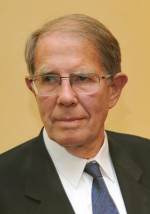
Horst Klein unexpectedly died in the presence of his family on 2nd December 2012. Horst Klein was, over several decades, head of the Institute for Applied Physics at the Goethe-University in Frankfurt, Germany. He was a popular lecturer but promoting young academics in the field of Accelerator Physics was a passion. Many of his over 70 doctoral students are successfully working at facilities around the world.
For many decades Horst Klein took part in the work of the LINAC community with enthusiasm and passion. At the Institute of Applied Physics of the Goethe-University he was fascinated as a student by accelerators as pursued by his academic teacher Prof. Dänzer. An important development, as a Ph.D. student, was the Helix ion accelerator beam dynamics and technology, which later on inspired many institutes worldwide. Horst Klein was involved in the first superconducting development of a helical proton accelerator cavity at FZ Karlsruhe, which was tested there successfully with beam.
In 1972 Horst Klein became a professor at Frankfurt University. One remarkable activity was his involvement in the design process and improvement of the GSI linear accelerator UNILAC. During the decades IAP Frankfurt contributed RFQ and buncher cavities to GSI as well as to many other accelerator facilities around the world. A very important ascpect of Horst Klein was the large network of relationships he established within the international accelerator community - many of these connections turned into friendships
Since the late seventies he was involved in the design of a large spallation neutron source and he contributed considerably to the first ESS design report. From the very beginning, Horst Klein was fascinated by the idea of nuclear waste transmutation; he was active in the European MAX project for MYRRHA until his last days. During the nineties a working group was initiated at IAP cooperating with DESY on linear collider cavity development. Last, but not least, his prominent contributions to heavy ion driven inertial fusion, to magnetic fusion via the test facility IFMIF and to intense ion source development have to be mentioned.
Horst Klein was also very active in various functions for the Goethe-University. His diplomatic and kind manner was helpful in finding acceptable compromises even in extremely difficult situations. He served on many committees related to accelerator and nuclear physics programmes.
International conferences were always an important place for him to exchange ideas and to have discussions with the leading experts in the field. As a consequence he was willing to serve for many years as a member in programme and organizing committees: The LINAC conference was best suited for his research activities. Additionally, he was one of the initiators of EPAC, which now is part of IPAC, and of ECAART. His care to give all students and institute staff members an opportunity to attend conferences, to present and to discuss their latest results was very important to Horst.
We will keep a thankful memory of him.
Ulrich Ratzinger, Institute of Applied Physics at Goethe-University, Frankfurt
Winfried Barth, GSI Helmholtzzentrum für Schwerionenforschung, Darmstadt